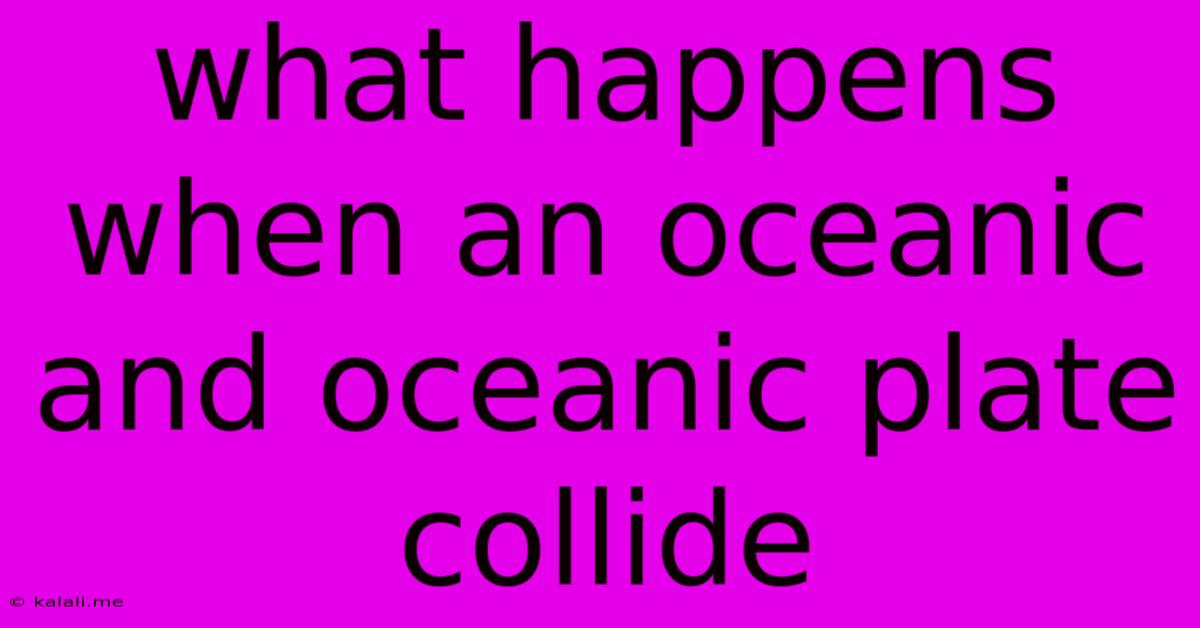What Happens When An Oceanic And Oceanic Plate Collide
Kalali
May 09, 2025 · 3 min read

Table of Contents
What Happens When Oceanic and Oceanic Plates Collide? A Deep Dive into Subduction Zones
When two massive oceanic plates collide, the result is a dramatic display of Earth's immense power, shaping the ocean floor and influencing global climate. Unlike the collision of continental plates which results in mountain ranges, the interaction of oceanic plates leads to the formation of subduction zones, volcanic island arcs, and powerful earthquakes. This article will delve into the processes involved in this geological phenomenon.
Meta Description: Discover the powerful forces at play when two oceanic plates collide. Learn about subduction zones, volcanic island arcs, and the resulting earthquakes and tsunamis in this comprehensive guide.
The denser of the two oceanic plates will be forced beneath the other in a process called subduction. This sinking plate melts as it descends into the Earth's mantle, creating magma. This magma, less dense than the surrounding mantle, rises to the surface, often erupting to form a chain of volcanoes known as a volcanic island arc. Think of the Japanese archipelago or the islands of the Philippines; these are prime examples of volcanic island arcs formed by oceanic-oceanic plate convergence.
The Subduction Process: A Detailed Look
The subduction process isn't simply a smooth descent. It's a complex interaction characterized by significant friction and pressure. This friction generates immense heat and pressure, leading to the melting of the subducting plate and the surrounding mantle rock. The molten rock, or magma, then rises, often finding weaknesses in the overlying plate to erupt. This volcanic activity is a defining characteristic of oceanic-oceanic plate convergence.
Earthquakes: A Consequence of Collision
The movement of tectonic plates is rarely smooth. Instead, they often stick and slip, resulting in the release of tremendous energy in the form of earthquakes. Oceanic-oceanic plate collisions are particularly prone to generating powerful earthquakes, often occurring along the subduction zone itself. These earthquakes can be incredibly destructive, causing tsunamis and widespread damage. The depth of these earthquakes can vary depending on the angle of subduction and the depth of the subducting plate. Megathrust earthquakes, some of the most powerful earthquakes on Earth, often originate along these subduction zones.
Formation of Trenches: Deepest Parts of the Ocean
Another defining feature of oceanic-oceanic plate convergence is the formation of oceanic trenches. These are extremely deep, elongated depressions in the ocean floor formed where the subducting plate bends downwards. The Mariana Trench, the deepest part of the world's oceans, is a prime example, formed by the subduction of the Pacific Plate beneath the Philippine Plate. These trenches represent the most significant topographic features of the ocean floor.
Other Geological Features: More Than Just Volcanoes and Trenches
Beyond volcanic arcs and trenches, the collision of oceanic plates can also lead to the formation of other geological features, including:
- Accretionary wedges: These are accumulations of sediments and rocks scraped off the subducting plate and piled onto the overriding plate. These wedges contribute to the growth of the volcanic arc and the surrounding seafloor.
- Back-arc basins: In some cases, the overriding plate may be stretched and thinned, leading to the formation of a basin behind the volcanic arc. These basins often have unique geological characteristics.
The Impact on the Global Ecosystem
The processes involved in oceanic-oceanic plate convergence significantly impact the global ecosystem. Volcanic eruptions release gases into the atmosphere, influencing climate patterns. The formation of island arcs creates new habitats for marine and terrestrial life. However, the powerful earthquakes and tsunamis generated by these collisions can cause devastating natural disasters, leading to loss of life and significant environmental damage.
Understanding the dynamics of oceanic-oceanic plate collisions is crucial for predicting and mitigating the risks associated with these powerful geological events. Continued research and monitoring of these zones are essential for enhancing our ability to prepare for and respond to natural disasters.
Latest Posts
Latest Posts
-
What Is 59 Degrees Celsius In Fahrenheit
May 09, 2025
-
40 Is What Percent Of 70
May 09, 2025
-
16 12 As A Mixed Number
May 09, 2025
-
10 Is What Percent Of 90
May 09, 2025
-
Determine The Mass Of The Sun
May 09, 2025
Related Post
Thank you for visiting our website which covers about What Happens When An Oceanic And Oceanic Plate Collide . We hope the information provided has been useful to you. Feel free to contact us if you have any questions or need further assistance. See you next time and don't miss to bookmark.